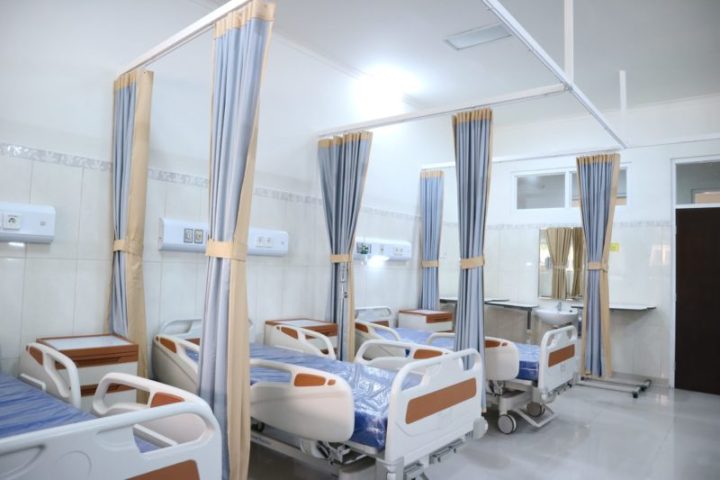Hospital beds are a healthcare facility’s most essential medical equipment. Properly maintained hospital beds ensure the comfort and safety of your patients and employees.
Hospital beds are much more technology intensive than standard beds because they’re designed to provide security and support for those needing care. At the same time, hospital beds also simplify and optimize the work of caregivers by offering mobility and efficient communication between patients and medical staff.
A proper maintenance program is not only required by The Joint Commission but also important to ensure safe operations and a long-life span for hospital beds. In order to function effectively and last a long time, hospital beds need to be cared for and maintained. Therefore, poor maintenance may even put patients at risk of injury.
Let’s learn more about the significance of hospital bed maintenance. In order to better understand the risks, let’s first take a closer look at the structure and common components of a typical hospital bed.
Structure and Functions of a Hospital Bed
Hospital beds help clinicians provide patient care with the highest safety standard through technology. Given the wide range of patient health issues, hospital beds are made to accommodate different needs and alert caregivers of any accidents.
A hospital bed requires a structure that improves patient positioning and mobility while preventing any harm, such as falls or bedsores. Therefore, an effective bed structure allows caregivers to reach patients from all directions to bathe them, care for any wounds, and provide for any other needs.
It is important that medical equipment, such as a hospital bed, is adequately equipped with the proper risk mitigation and safety features when providing patients with the best possible care. Some examples of built-in risk mitigation tools include:
- CPR emergency release
- control panels for patients and caregivers
- side rails for patients’ mobility support
- entrapment sensors
- quick release cabling
- adjustable settings (height, mattress positioning, bed frames, and rails)
- steering and locking mechanism
- bed exit alarms
- lighting
Caregivers must receive specialized training to leverage all these safety features and reinforce standardized safety protocols. These protocols are implemented by the Department of Health in several states and are based on the FDA and the HBSW (Hospital Bed Safety Workshop) guidance.
Hospital beds are regularly inspected to ensure that a healthcare facility follows all the regulations. Complying with safety protocols is another good reason why proper maintenance is essential.
Who Should Perform Hospital Beds Services and Maintenance?
The Department of Health and Human Services strongly recommends that only trained and qualified biomedical service technicians service and maintain hospital beds.
The following factors below are some additional ways your healthcare facility can benefit from maintenance that is handled by a qualified professional. Some advantages are:
- reducing risks to staff and patients.
- extending the life of your medical equipment.
- reducing equipment downtime.
- ensuring beds are always available when your patients need them.
Clinical engineers develop preventive maintenance management planes that ensure optimal operation, utilization, and function of hospital beds, that will help reduce the risk of accidents and keep your patients comfortable during their hospital stay.
Professional Hospital Bed Maintenance Services and Best Practices
Comprehensive maintenance programs ensure each feature of the hospital bed meet the manufacture’s recommended level of performance. Problems with brakes, casters, and rail stability are a few examples of mechanical failures that can lead to serious patient injury but can be prevented with proper maintenance. Hospital beds have many components that need proper care in order to function efficiently and safely. Let’s learn more about some of the well-known and not so well-known hospital bed functions that require routine maintenance.
Side Rails
One of the components of hospital beds that is damaged the most is the side rails. Patients often use them to support their weight when getting in and out of bed. In addition to providing a secure grip for patients, they are also important for providing communication features that allow patients to request caregivers.
A defective rail can loosen over time and collapse under pressure leading to patient injury or fall. Also, side rails that cannot be adequately tucked are often damaged during transportation from running into doors, walls, and other equipment. They require regular lubrication and adjustment to prevent malfunction.
Scale & Bed Exit
Scales are an essential hospital bed built-in tool to monitor patients’ overall health and recovery. This helps the medical staff determine the appropriate medication dosage or care strategy according to the patient’s weight and needs. However, the scale may lose some accuracy over time, which is why occasional calibration and maintenance are necessary for safety measures.
Additionally, defective or inaccurate scales directly impact hospital beds’ built-in exit systems, which are responsible for monitoring patient movement. If the scale doesn’t function well, it will give caregivers a false sense of security and can ultimately increase the chance of patient injury.
Linen Dust
Although changing hospital bed sheets frequently may seem less important than other items, the buildup of dust can cause damage to the medical equipment. If the dust accumulates in the filtration system or directly on the electronic components, it can cause sensors to malfunction and parts to overheat. It is crucial to vacuum the internal compartments of the bed and filters regularly to prevent damage from linen dust.
Nurse Call
Patients rely on nurse call systems as an essential line of communication between themselves and their healthcare providers. When a nurse call system malfunctions, it causes the patient unnecessary stress and significantly lowers their overall satisfaction. With the help of a qualified professional, healthcare facilities can assess what needs to be repaired. It is important for a patient’s well-being that the nurse call is always operating correctly.
Electrical Safety
Most medical equipment in a healthcare facility requires annual electrical safety checks. That is also a factor that must be inspected for hospital beds. In a fast-moving healthcare environment, it is essential to ensure patients move from one location to another quickly. During an emergency, caregivers often forget to unplug or secure the power cords, and communication cables before moving the beds and stretchers. Due to moving consistently, hospital beds end up with significant damage. Electrical safety checks reduce the risk of patient harm from damaged electrical cables.
Emeritus Provides Efficient Hospital Bed Maintenance
In order to provide proper care and safety for patients, hospital bed maintenance should be your healthcare facility’s top priority. Emeritus guarantees success and will work with you to create a customized package for proper medical equipment maintenance. We will ensure that all your medical equipment, such as hospital beds, function effectively for a very long time.
Emeritus will assist you in all aspects of proper maintenance, and we offer on-site flexible service plans that comply with all manufacturer recommendations. Your healthcare facility can focus on providing the best patient care possible while our qualified professional provides high-quality maintenance for your medical equipment. Discover our solutions today.




